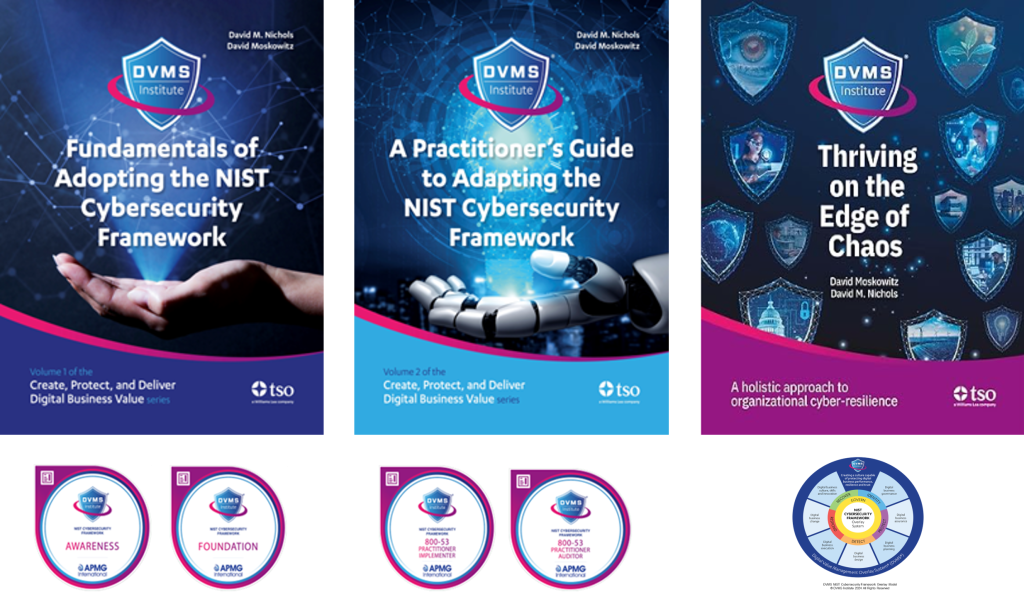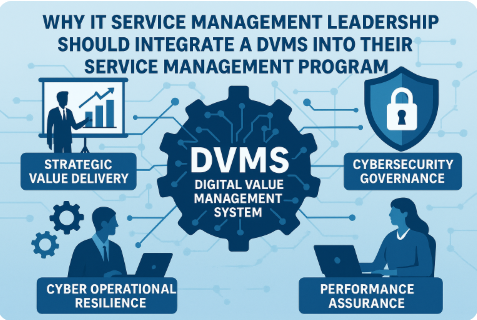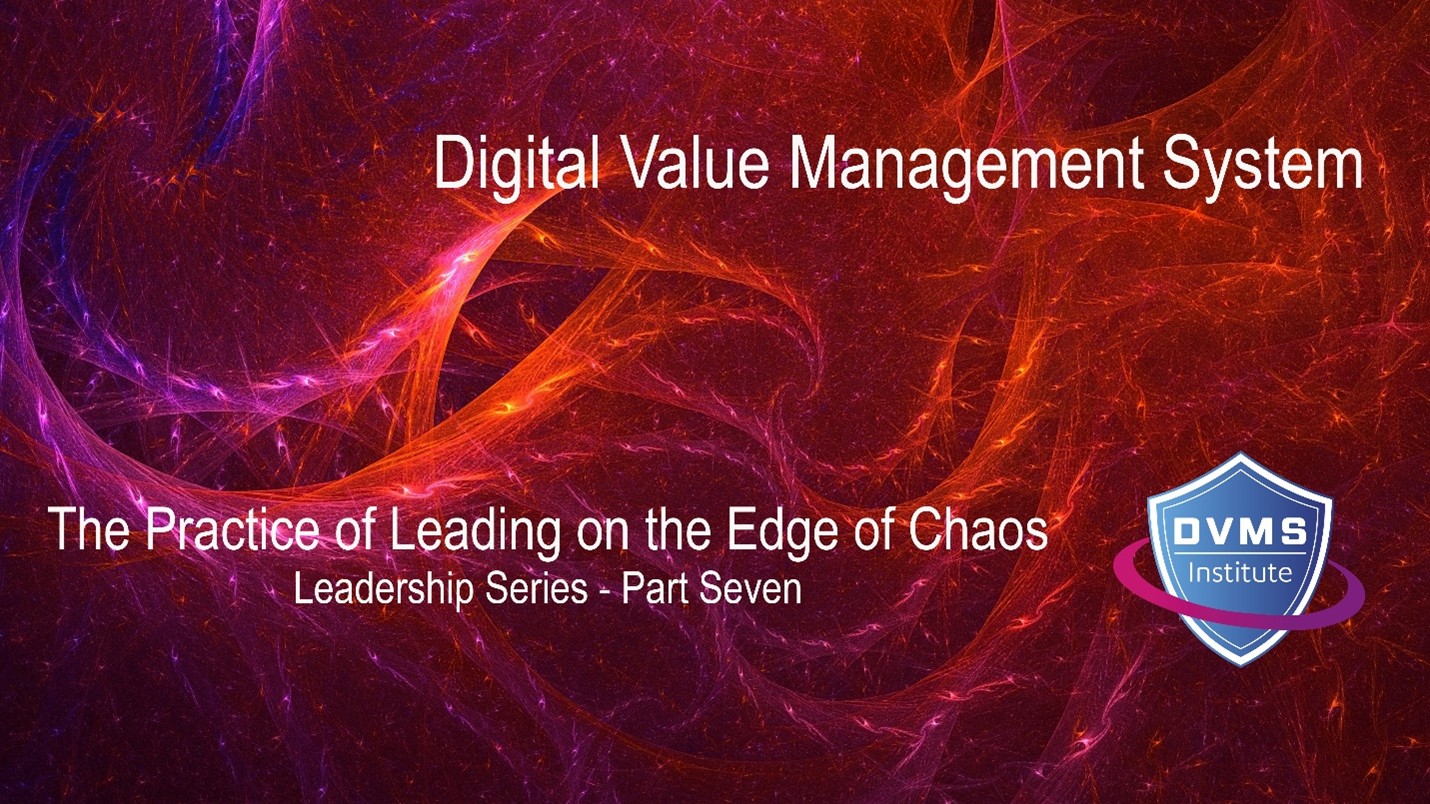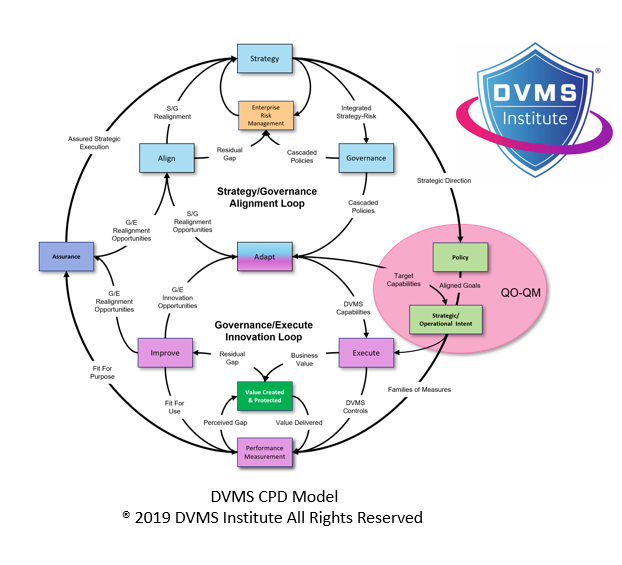A New Imperative for ITSM Leadership – Integrating a DVMS to Protect Organizational Digital Value and Resiliency
Rick Lemieux – Co-Founder and Chief Product Officer of the DVMS Institute
A New Imperative for IT Service Management
In today’s volatile, uncertain, complex, and ambiguous (VUCA) digital environment, traditional IT Service Management (ITSM) models are increasingly insufficient to meet the demands of modern enterprises. The persistent threat of cyberattacks, the rapid evolution of technology, and the pressure to deliver continuous value creation have transformed the IT service teams’ landscape. Against this backdrop, integrating a Digital Value Management System (DVMS) into service management programs is beneficial and essential. The DVMS, when used in alignment with the NIST Cybersecurity Framework (CSF) 2.0, provides ITSM teams with governance and cultural capabilities to achieve operational resilience, assure performance, and protect digital business value.
From Technical Operations to Strategic Value Delivery
The first and most transformative advantage of integrating DVMS into ITSM is the shift from a purely technical support role to one of strategic value creation and protection. Traditionally, IT service teams focused on system uptime, incident response, and user support. However, as stated in the DVMS Institute’s Practitioner’s Guide to Adapting the NIST Cybersecurity Framework, this siloed view of IT creates blind spots in managing digital business risk. DVMS reframes ITSM as a core component of enterprise strategy-risk, a unified view where business strategy and risk are inseparably linked.
By adopting the DVMS framework, IT service teams gain a new lens through which they can assess their contributions to business outcomes. Every ticket resolved, every system updated, and every process optimized becomes a node in the larger system of creating, protecting, and delivering digital value. This alignment enables the service team to elevate its organizational role, providing strategic assurance rather than just technical support.
The Systems Thinking Mindset: Seeing the Whole, Not the Hole
Central to the DVMS approach is systems thinking—recognizing that organizations function as complex adaptive systems composed of interconnected parts. For ITSM teams, this perspective is critical. It encourages them to consider not just the immediate task at hand, but also how their actions interact with broader organizational processes and goals. As detailed in the Institute’s Thriving on the Edge of Chaos publication, leveraging systems thinking helps teams shift from a reactive mode to one of anticipation and adaptability.
The DVMS Z-X Model structures these insights into seven minimum viable capabilities: Govern, Assure, Plan, Design, Change, Execute, and Innovate. ITSM teams already operate across many of these domains. By overlaying the DVMS model, they can identify performance gaps, align activities with strategic goals, and systematically improve service delivery and cybersecurity posture.
Cybersecurity as a Byproduct of Value Management
Cybersecurity is no longer a specialized IT concern but a fundamental business risk. The DVMS approach reframes cybersecurity not as a bolt-on requirement, but as a natural byproduct of quality digital value delivery. In other words, unprotected digital value has no value. The NIST CSF 2.0 reinforces this by placing “Govern” at the core of its framework, emphasizing that cybersecurity governance is an enterprise-wide concern.
Integrating DVMS allows ITSM teams to align their daily activities with cybersecurity governance and risk management goals. This includes embedding practices from the CSF Core Functions—Govern, Identify, Protect, Detect, Respond, and Recover—into service workflows. With this alignment, ITSM functions such as change management, incident response, and configuration management become avenues for enhancing security and resilience.
Operational Resilience Through Continuous Learning and Adaptation
The DVMS encourages a culture of continual learning, experimentation, and improvement—qualities essential for resilience. According to the Institute’s Practitioner’s Guide, the DVMS fosters a “questioning culture” in which IT teams proactively seek out system vulnerabilities, probe assumptions, and use feedback loops to improve outcomes.
This is particularly important in the context of today’s dynamic threat landscape. Rather than reacting to threats after the fact, DVMS helps ITSM teams evolve into proactive defenders. Tools such as red teaming, ethical hacking to simulate real-world attacks, and the Goal-Question-Metric methodology enable teams to identify weaknesses before adversaries do.
Furthermore, the DVMS FastTrack™ approach supports scalable adoption by encouraging organizations to start small and expand iteratively. This phased model aligns well with ITIL’s continual service improvement and supports agile, DevOps, and hybrid environments.
Breaking Silos and Enhancing Collaboration
One persistent challenge in ITSM is siloed operations, where development, operations, security, and governance functions operate in parallel but disconnected tracks. DVMS addresses this by emphasizing collaboration across all business and technical domains. The overlay model doesn’t replace existing frameworks like ITIL or COBIT but integrates with them to ensure seamless communication and consistent risk governance across the enterprise.
The DVMS also empowers ITSM teams to communicate their impact better using the language of business value. Instead of reporting only on uptime or ticket volume, teams can demonstrate how their work reduces risk, protects assets, and supports business continuity—metrics that resonate with executive leadership and the board.
Culture as Strategy: Making Security Stick
Culture plays a pivotal role in the success of any governance model. The DVMS approach, supported by CSF 2.0, recognizes that organizational culture is either an enabler or an obstacle to resilience. By shifting the perception of ITSM from cost center to strategic partner, and cybersecurity from a burden to a value enabler, DVMS changes the conversation across the enterprise.
The cultural transformation includes equipping every team member—from help desk staff to service managers—with the mindset that their actions contribute to protecting digital business value. This creates a resilient, risk-aware workforce capable of navigating complex challenges with agility and foresight.
Conclusion: A Strategic Imperative, Not an Option
Incorporating a Digital Value Management System into IT Service Management is no longer a theoretical best practice but a practical necessity. The integration enables service teams to operate as technical responders and strategic enablers of business resilience, innovation, and trust.
The DVMS framework, when applied in alignment with NIST CSF 2.0, transforms the ITSM function into a system that can continuously adapt, learn, and deliver secure digital value in a complex digital ecosystem. For organizations seeking to thrive rather than merely survive, integrating DVMS is not just a step forward—it is the step in the right direction.
About the Author

Rick Lemieux
Co-Founder and Chief Product Officer of the DVMS Institute
Rick has 40+ years of passion and experience creating solutions to give organizations a competitive edge in their service markets. In 2015, Rick was identified as one of the top five IT Entrepreneurs in the State of Rhode Island by the TECH 10 awards for developing innovative training and mentoring solutions for boards, senior executives, and operational stakeholders.
In today’s digitally driven economy, cyber disruptions are no longer an “if” but a “when.”
The DVMS Institute’s Certified Training Programs teach organizations the skills to build a Holistic and Culture-Aligned Overlay System capable of coordinating Adaptive, Governance, Resilience, and Assurance actions across a Complex Digital Ecosystem.
Achieving true cyber resilience across a complex digital ecosystem requires seamless alignment between organizational Strategy, Governance, and Operations, underpinned by a culture dedicated to sustaining and continuously innovating organizational digital value.

The DVMS positions cyber resilience as a strategic, enterprise-wide capability powered by the Institute’s CPD, Z-X, and 3D Knowledge models.
This systems-based approach to cyber operational resilience demands active engagement from all members of the Digital Ecosystem, with each member playing a distinct role in proactively identifying and mitigating the systemic risks that threaten digital business operations.
This adaptive, forward-looking approach to Governance, Resilience, and Assurance (GRA) positions businesses to:
- Maintain Operational Stability Amidst Constant Digital Disruption
- Drive Agility and Trust Across Your Digital Ecosystem
- Satisfy Critical Regulatory and Certification Requirements
- Leverage Cyber Resilience as a Competitive Advantage
DVMS Explainer Videos
- Architecture Video: David Moskowitz explains the DVMS System
- Case Study Video: Dr. Joseph Baugh Shares His DVMS Story.
- Overlay Model – What is an Overlay Model
- ZX Model – The MVC’s that power operational resilience
- CPD Model – Adaptable governance and assurance
- 3D Knowledge Model – Enabling holistic organizational learning
- FastTrack Model – A phased approach to cyber resilience
Digital Value Management System® is a registered trademark of the DVMS Institute LLC.
® DVMS Institute 2025 All Rights Reserved




